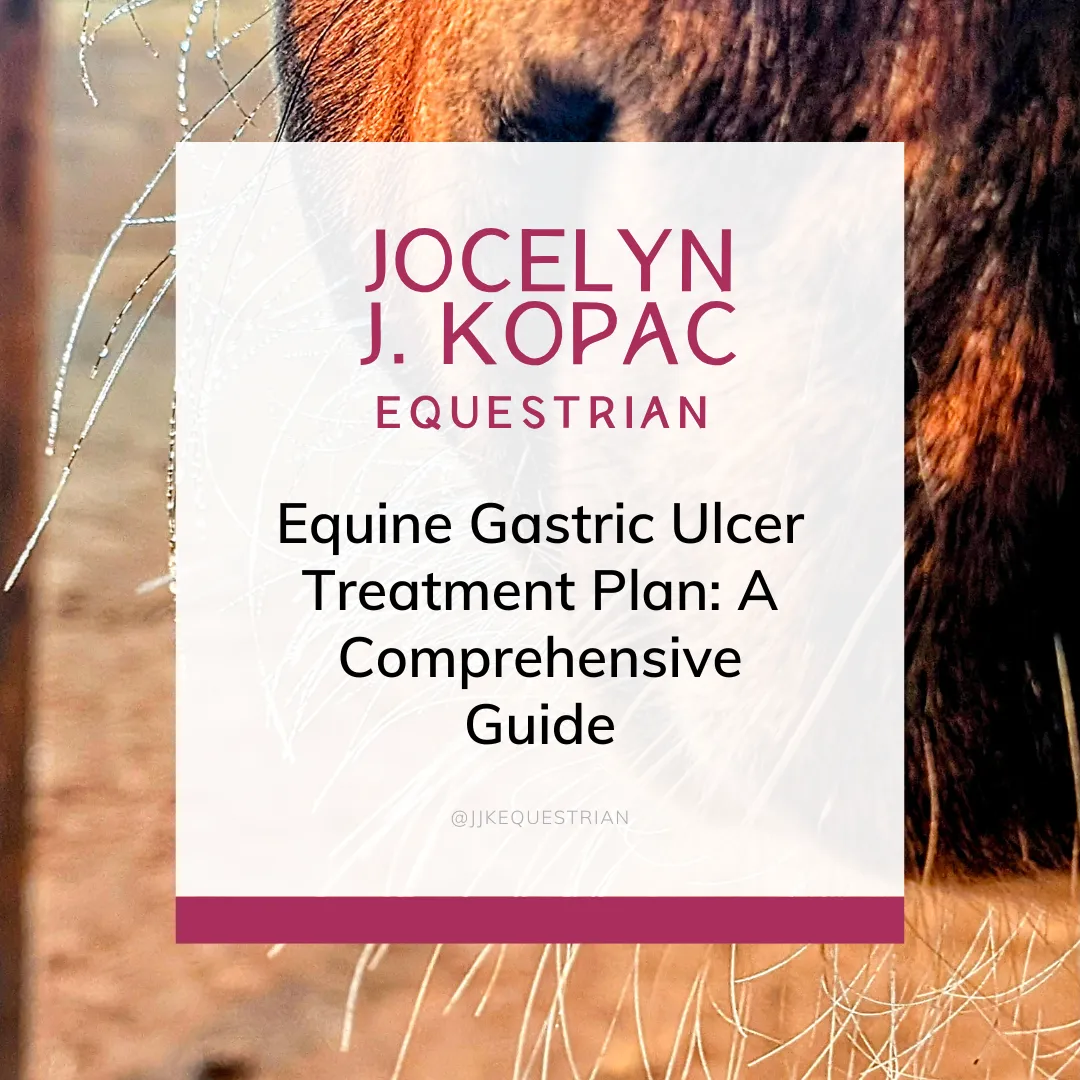JJK Equestrian Blog
Where Passion Meets the Saddle

Equine Gastric Ulcer Treatment Plan: A Comprehensive Guide to Relief and Prevention
Treating Indra and Bernie’s Ulcers with Knowledge and Care
Indra and Bernie, my Dutch Harness Horses, embody everything their breed is known for—high work ethics, sensitivity, and athleticism. Unfortunately, these traits also come with a downside: a heightened predisposition to ulcers. Both of my horses have endured starvation in their past, which significantly increases their risk of developing ulcers.
It’s estimated that 80–90% of working performance horses, essentially any horse not simply grazing in a field, will be diagnosed with some form of ulcer at some point in their lives.
As someone who isn’t made of money, I knew I needed a cost-effective approach to both prevent and treat ulcers while keeping Indra and Bernie healthy. I dove deep into research, exploring proper nutrition and vitamin balance to reduce the frequency of ulcer flare-ups.
While well-known treatments like UlcerGard and GastroGard are highly effective, they can cost upwards of $1,500 per month, with alternatives like Abler’s Abrazole still costing around $300 per month.
Knowing that my horses frequently attend shows and clinics, I needed a solution that offered reliable protection without breaking the bank.
Additionally, I wasn’t comfortable leaving them on daily doses of 80-plus milligrams of Omeprazole long-term.
Omeprazole works by turning off the stomach’s proton pump, reducing acid production. However, once the treatment ends, the proton pump can rebound with excessive acid production, potentially creating a vicious cycle. I wanted a safer, more sustainable solution.
That’s when I discovered a 2009 scientific study on Esomeprazole Magnesium as an ulcer treatment for horses. This study highlighted its effectiveness in managing ulcers in some of the most prone horses—racing Thoroughbreds, where over 90% are affected.
With this research in hand, I felt confident that Esomeprazole Magnesium was the best ulcer treatment for my horses and began incorporating it into Indra and Bernie’s care plan. This article will outline everything I’ve learned about recognizing, treating, and preventing ulcers, so you too can help your horses thrive.
-- Get My Equine Gastric Ulcer Treatment Plan For FREE --
Treating Indra and Bernie’s Ulcers with Knowledge and Care
The Two Types of Equine Gastric Ulcers
Common Causes of Ulcers in Horses
Treating Gastric Ulcers in Horses: My Personal Approach
Why I Chose Esomeprazole Magnesium
What Are Ulcers in Horses?
Equine gastric ulcers are a widespread condition affecting horses, especially those in work or competition. These ulcers occur when the horse’s stomach lining becomes irritated or damaged due to excessive stomach acid. It’s a common problem, with research showing that gastric ulcers in horses affect up to 90% of performance horses and a significant percentage of pleasure horses as well. Understanding the two types of ulcers, their causes, and how to identify them is essential for every horse owner.
The Two Types of Equine Gastric Ulcers
Horses can suffer from two distinct types of stomach ulcers, each affecting different parts of the stomach:
Equine Squamous Gastric Disease (ESGD)
This type affects the squamous or upper portion of the stomach, which lacks protective mucus. Equine gastric ulcer syndrome grading for ESGD focuses on the severity of lesions in this area, which can develop quickly due to prolonged exposure to stomach acid.Equine Glandular Gastric Disease (EGGD)
EGGD occurs in the glandular or lower portion of the stomach, which is designed to handle stomach acid but can still be damaged under certain conditions. Equine glandular gastric disease is less common than ESGD but often more challenging to treat.
Understanding these distinctions helps in diagnosing and determining the best ulcer treatment for horses based on the specific type and severity of their condition.
Common Causes of Ulcers in Horses
Horses are naturally prone to ulcers due to the anatomy of their equine stomach and their unique digestive process. Key causes include:
Dietary Issues: Feeding large, infrequent meals of grain or concentrates leads to increased acid production. On the other hand, continuous access to forage, such as alfalfa pellets for horses with ulcers, helps buffer stomach acid.
Stress: Horses subjected to frequent travel, competition, or environmental changes are more likely to develop ulcers.
Intense Exercise: Physical exertion increases abdominal pressure, pushing acid into unprotected parts of the stomach. This is why gastric ulcer disease in horses is so prevalent in performance animals.
Starvation or Poor Nutrition: Periods of fasting or insufficient access to hay or pasture increase the risk of ulcers. This is particularly true for rescue horses or those that have experienced starvation, like my own horses, Indra and Bernie.
Signs and Symptoms of Ulcers
Recognizing equine ulcer symptoms is crucial to addressing the issue promptly. Horses with ulcers may show subtle behavioral changes, such as:
Loss of appetite, particularly for grain
Girthiness or sensitivity when saddling
Behavioral issues, such as bucking or reluctance to move forward (horse ulcers bucking)
Physical symptoms of gastric ulcers in horses vary in severity and may include:
Weight Loss: Horses with ulcers often struggle to maintain weight despite adequate feeding.
Poor Coat Condition: A dull or rough coat can be a subtle indicator of digestive distress.
Loss of Appetite: Many horses with ulcers become picky eaters, avoiding grain or concentrates while showing some interest in forage.
Mild Colic Episodes: Horses may exhibit discomfort after eating, sometimes mistaken for colic.
These equine ulcer symptoms often overlap with other conditions, so it’s essential to investigate further if you suspect your horse has ulcers.Symptoms can vary, but any change in your horse’s behavior or physical condition should prompt an evaluation for equine gastric ulcers.
Prevention and Management
Preventing ulcers often starts with diet. Feeding high-quality forage like alfalfa pellets for horses with ulcers and avoiding prolonged fasting helps protect the stomach lining. Supplements, such as a balancer for horses with ulcers, can also ensure your horse gets the necessary nutrients without excess starch.
For horses prone to ulcers, feeding beet pulp to horses with ulcers can be another helpful strategy. Beet pulp is low in sugar and acts as a fiber source that supports digestion. Overall, equine gastric ulcers feeding should focus on forage-first diets, with limited grain and plenty of access to fresh water.
Is Scoping Necessary?
Gastroscopy, or “scoping,” is the gold standard for diagnosing ulcers. During this procedure, a veterinarian uses an endoscope to examine the equine stomach and identify the location and severity of ulcers. This process also allows for equine gastric ulcer syndrome grading, helping determine whether the ulcers are squamous or glandular in origin.
Pros of Scoping:
Confirms the presence of ulcers.
Differentiates between equine glandular gastric disease and squamous ulcers.
Ensures treatment is targeted and effective.
Cons of Scoping:
Cost: Scoping typically costs $300–$800, depending on the veterinarian and facility.
Preparation: Horses must fast for 12–24 hours before the procedure.
Veterinarian Involvement: This diagnostic tool must be performed by a qualified vet, adding to the expense.
If you’re unsure whether scoping is right for your horse, consult your vet and evaluate the severity of their equine ulcer symptoms. While scoping provides the most accurate diagnosis, the cost may be prohibitive for some horse owners.
Monitoring and Next Steps
If scoping isn’t immediately feasible, you can still observe for symptoms of ulcers in horses and consult your vet for guidance. Behavioral changes, weight loss, and poor appetite are clear signs that your horse might benefit from a more ulcer-friendly diet and treatment.
Treating Gastric Ulcers in Horses: My Personal Approach
Disclaimer: I am not a veterinarian. I’m a biomechanics barefoot farrier, equine enthusiast, and dressage rider working toward my competition goals. This treatment plan is based on my personal research and experience with my horses, Indra and Bernie. Please consult your veterinarian before implementing any treatment for your horse.
My Treatment Plan
When both Indra and Bernie exhibited equine ulcer symptoms, I researched affordable and effective alternatives to the popular (and costly) GastroGard vs UlcerGard debate. Spoiler: they’re the same product, with the same active ingredient (omeprazole), just marketed differently.
After coming across a scientific study highlighting the efficacy of esomeprazole magnesium for treating equine gastric ulcers, I decided to try it with my horses.
> Here’s the plan in PDF Format! <
Why I Chose Esomeprazole Magnesium
The choice between generic ulcer medication for horses and branded products like GastroGard/Ulcergard came down to two key factors:
Cost: GastroGard or UlcerGard can cost up to $1,500 per month for full treatment, while abrazole is far more affordable at roughly $300 per month, BUT!
Esomeprazole Magnesium is by far the cheapest route at only about $55 for a full course of treatment.
Scientific Backing: Research supports the use of esomeprazole magnesium for severe gastric ulcers in horses, particularly in performance breeds like Thoroughbred and Dutch Harness Horses.
Helpful Scientific Resources:- Study on Esomeprazole’s Efficacy in Horses
- Preliminary Study of the Gastric Acidity in Thoroughbred Horses at Rest after Enteral Administration of Esomeprazole Magnesium (Nexium)
Why Choose Tablets Over Capsules?
Tablets are easier to administer compared to capsules, as the capsules can break open and create a mess in the barn. Tablets, on the other hand, can be easily placed directly in your horse's grain and soaked, allowing your horse to consume them without any hassle or mess.
Rehabilitation and Feeding for Ulcer Recovery
Rehabilitating a horse recovering from gastric ulcers requires careful attention to diet, feeding habits, and gradual return to work. Since a horse’s stomach produces acid 24/7, ensuring they have consistent access to forage is essential during treatment, recovery, and beyond. Here are my key strategies for supporting recovery and preventing future ulcers:
The Importance of 24/7 Forage
Horses evolved to graze throughout the day, and their stomachs are designed to process small amounts of food continuously. Unlike humans, whose proton pumps shut off when we’re not eating, a horse’s proton pump stays active around the clock. Without constant forage, stomach acid builds up, exacerbating equine gastric ulcers.
Options for Continuous Forage:
Slow-feed hay nets to control intake and prevent waste.
Free-choice hay for horses with higher calorie needs.
Adding alfalfa pellets for horses with ulcers as a buffer to stomach acid.
Feeding the Right Diet
Nutrition plays a crucial role in ulcer recovery and prevention. Here’s what I include in my horses’ diets:
Low-Starch, Low-Sugar Balancers
Balancers are like vitamins for horses. However, high-sugar or high-starch balancers can aggravate ulcers. Opt for a balancer for horses with ulcers that prioritizes low sugar and starch content.
For additional vitamin E, I recommend natural options when possible, especially for horses without regular access to grass. Hay has lower vitamin E levels, so supplementing is often necessary.
High-Fiber Feeds
Beet pulp is a fantastic high-fiber option that helps support gut health and digestion during recovery.
Alfalfa pellets not only provide protein but also help buffer stomach acid.
Hydration and Monitoring
Ensure clean, fresh water is always available. Monitor your horse’s water intake and look for signs of dehydration or discomfort.
Want my ulcer prevention and rehab feed plan? CLICK HERE
Gradual Return to Work
Once treatment begins, give your horse 1–2 weeks off to allow their body to start healing. When bringing them back into work, prioritize low-stress, light activities that don’t demand excessive mental or physical effort.
Tips for Riding Horses with Ulcers:
Go slow and keep sessions short.
Observe their behavior—reactivity or flightiness may indicate lingering discomfort.
Monitor their poop and overall appetite as indicators of gut health.
Long-Term Prevention
Ulcer prevention is a lifelong commitment for horses prone to digestive issues. By ensuring consistent forage, a balanced diet, and mindful management of stressors, you can keep your horse’s stomach healthy and minimize the risk of recurrence.
Incorporating feeds like alfalfa pellets, beet pulp, and a high-quality balancer, alongside proper care during work, has helped my horses thrive. With patience and vigilance, your horse can recover fully and get back to their best performance.
Can Ulcers Kill My Horse?
While equine gastric ulcers themselves aren’t directly fatal, the risks of untreated ulcers can lead to severe complications that may threaten your horse’s life.
If left unaddressed, ulcers can cause significant pain, reduce your horse’s appetite, and lead to weight loss, colic, or even perforation of the stomach lining in extreme cases. These complications can escalate quickly and become life-threatening, making early intervention essential.
Spending time with your horse and understanding their normal behavior is one of the best ways to catch ulcers early. Subtle changes, like reduced appetite, irritability, or behavioral shifts, may be the first signs of trouble.
When you know what “normal” looks like for your horse, you’re better equipped to notice these red flags and act quickly. Early intervention, combined with the right treatment and management strategies, can prevent minor symptoms from becoming major health issues.
Another critical factor in ulcer prevention is maintaining a healthy gut biome. Resetting and supporting your horse’s digestive system with a diet rich in forage, probiotics, and balanced nutrition gives them a fighting chance against ulcers.
A healthy gut helps regulate stomach acid, improves digestion, and builds resilience to stress, ultimately lowering the likelihood of ulcers returning. Proactive care and attention to their diet and behavior can go a long way in protecting your horse’s health.
Caring for Ulcer-Prone Horses with Knowledge and Commitment
Treating ulcers in Indra and Bernie has been a journey of learning, dedication, and compassion.
By diving into research, exploring cost-effective treatments, and tailoring their diets and management to their unique needs, I’ve been able to provide them with a higher quality of life. While equine ulcers are a common challenge, they are manageable with the right approach.
From understanding symptoms to exploring innovative solutions like generic Esomeprazole Magnesium, this experience has shown me that staying informed and proactive can make all the difference.
With patience, observation, and a commitment to your horse’s well-being, you can help them thrive, even in the face of health challenges.
Copyright ⓒ Kopac Enterprises LLC | 2024
Powered By TDMFunnels

